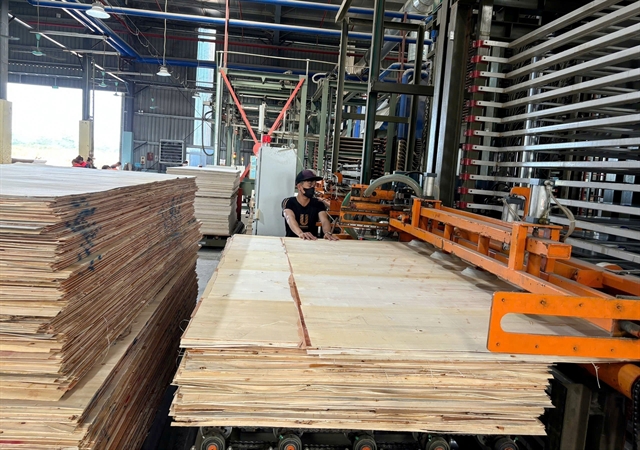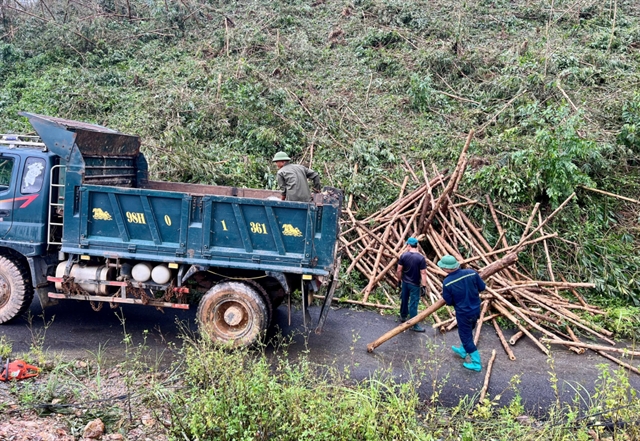 Economy
Economy

 |
| The Sao Việt wood and plywood factory in Tuyên Quang Province, under Sao Việt Tuyên Quang Co Ltd, resumed operations after the floodwaters receded. — VNA/VNS Photo |
HÀ NỘI — Việt Nam's wood and timber product exports have achieved remarkable results in the first nine months, with estimated revenues reaching almost US$12.2 billion, reflecting a 17.2 per cent increase compared to the same period in 2023.
Notably, wooden products accounted for the largest share at $7.84 billion, marking a 20.7 per cent increase. Raw timber also recorded substantial growth, valued at $3.53 billion, up 13.1 per cent. Non-timber forest products contributed $777 million, reflecting a 3.9 per cent increase.
The primary markets for Việt Nam's wood and timber products include the US, China and the European Union. The US leads the way with import values soaring to $5.9 billion, which constitutes 54.4 per cent of the total export revenue, a notable 24.7 per cent increase from 2023. Both China and Europe also experienced growth exceeding 20 per cent.
Despite encouraging growth amid a volatile global economy, the timber industry faces significant challenges from market dynamics and natural disasters in the final months of 2024.
Deputy Director of the Department of Forestry under the Ministry of Agriculture and Rural Development, Triệu Văn Lực, said that economic difficulties in key markets like the US, Japan and South Korea have reduced demand, while protective policies and strict timber regulations, such as the European Union Deforestation Regulations (EUDR), alongside anti-dumping investigations, add significant pressure on Vietnamese exporters.
In addition to these market pressures, geopolitical tensions and global economic fluctuations have raised risks for the timber industry, with soaring shipping costs and raw timber prices – some increasing by up to 40 per cent since 2023. This has pushed up production costs, while foreign importers demand price cuts, causing supply chain imbalances, Lực said.
He also mentioned issues related to the refunding of value-added tax (VAT) for companies producing plywood and wood chips remain problematic. Tax authorities' procedures for verifying the origin of timber from forest owners are lengthy, significantly impacting cash flow and the reinvestment capacity of businesses.
Severe damage from Typhoon Yagi
A key challenge for the Vietnamese forestry sector is the aftermath of Typhoon Yagi, which damaged nearly 170,000 hectares of forests across 13 provinces. Quảng Ninh was hardest hit with over 110,000 hectares affected, followed by Bắc Giang, Lạng Sơn and Hải Phòng.
 |
| The once lush green forests now remain with only broken tree trunks in Quảng Ninh Province after the storm. — Photo baoquangninh.vn |
Damaged forests will take between five and seven years to recover, causing a yearly shortfall of 3.5 million cubic metres of timber. This poses a major challenge for timber companies in maintaining production and quality, Lực said.
Manufacturing facilities for plywood, timber strips and veneer in northern provinces have faced severe losses, with around 200 businesses affected and damages estimated at VNĐ40 billion ($1.6 million). Roof damage and post-storm landslides have disrupted production.
In response to these difficulties, the Vietnamese forestry sector is focused on mitigating the aftermath of the storm to quickly stabilise production, Lực said, adding that the Department of Forestry has implemented support measures for affected businesses and is collaborating with localities to rapidly restore infrastructure and rebuild damaged forest areas.
In addition, he highlighted one of the primary strategies is to enhance the capacity of businesses to proactively address trade challenges, such as anti-dumping and subsidy cases. Trade promotion efforts are being intensified through the organisation of exhibitions and fairs to showcase and introduce Vietnamese timber products to the global market while seeking to explore and expand new markets.
Investment in forestry projects is also receiving increased attention. The 'Modernisation of the Forestry Sector and Enhancement of Coastal Resilience' (FMCR) project is a prime example.
However, due to the impact of the typhoon, some projects, such as FMCR, have suffered significant setbacks, particularly in regions like Quảng Ninh, Hải Phòng and Thanh Hóa. Mangrove reforestation areas under the project have been washed away by waves, with plants uprooted, causing considerable losses. This necessitates prompt recovery measures to protect and regenerate mangrove areas.
Despite export success, natural disasters and global market pressures are mounting. To achieve the 2024 export target of $15.2 billion, the sector must recover from disasters and boost international competitiveness. Strong collaboration between businesses and State agencies, along with technological investment and product quality improvements, is vital for sustainable growth, Lực said — VNS




